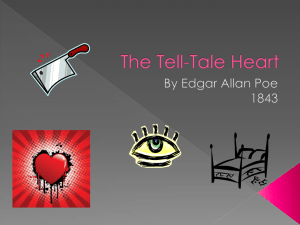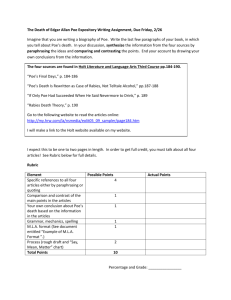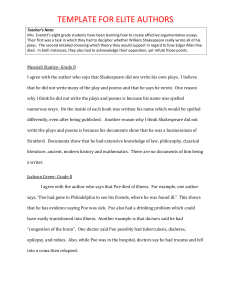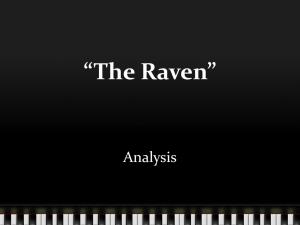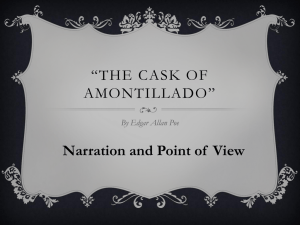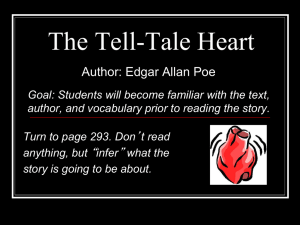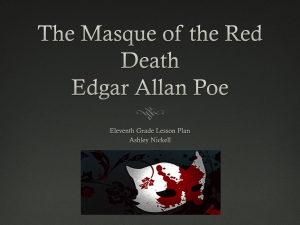Grade 9 ELA Module 2, Unit 1, Lesson 7
advertisement
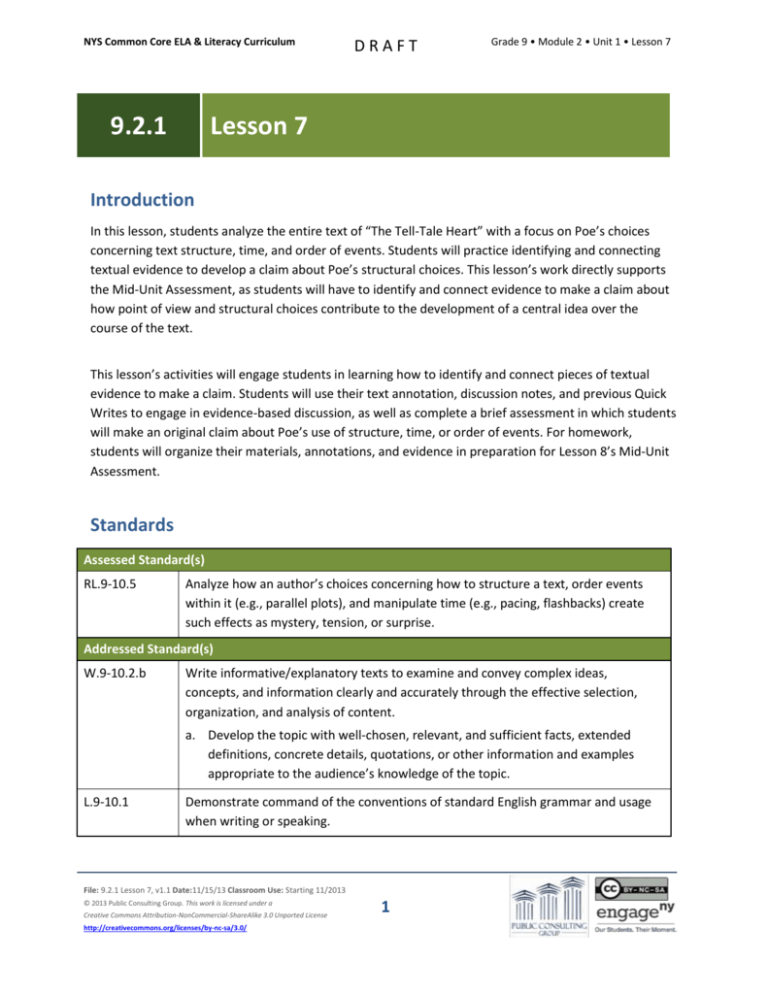
NYS Common Core ELA & Literacy Curriculum 9.2.1 DRAFT Grade 9 • Module 2 • Unit 1 • Lesson 7 Lesson 7 Introduction In this lesson, students analyze the entire text of “The Tell-Tale Heart” with a focus on Poe’s choices concerning text structure, time, and order of events. Students will practice identifying and connecting textual evidence to develop a claim about Poe’s structural choices. This lesson’s work directly supports the Mid-Unit Assessment, as students will have to identify and connect evidence to make a claim about how point of view and structural choices contribute to the development of a central idea over the course of the text. This lesson’s activities will engage students in learning how to identify and connect pieces of textual evidence to make a claim. Students will use their text annotation, discussion notes, and previous Quick Writes to engage in evidence-based discussion, as well as complete a brief assessment in which students will make an original claim about Poe’s use of structure, time, or order of events. For homework, students will organize their materials, annotations, and evidence in preparation for Lesson 8’s Mid-Unit Assessment. Standards Assessed Standard(s) RL.9-10.5 Analyze how an author’s choices concerning how to structure a text, order events within it (e.g., parallel plots), and manipulate time (e.g., pacing, flashbacks) create such effects as mystery, tension, or surprise. Addressed Standard(s) W.9-10.2.b Write informative/explanatory texts to examine and convey complex ideas, concepts, and information clearly and accurately through the effective selection, organization, and analysis of content. a. Develop the topic with well-chosen, relevant, and sufficient facts, extended definitions, concrete details, quotations, or other information and examples appropriate to the audience’s knowledge of the topic. L.9-10.1 Demonstrate command of the conventions of standard English grammar and usage when writing or speaking. File: 9.2.1 Lesson 7, v1.1 Date:11/15/13 Classroom Use: Starting 11/2013 © 2013 Public Consulting Group. This work is licensed under a Creative Commons Attribution-NonCommercial-ShareAlike 3.0 Unported License http://creativecommons.org/licenses/by-nc-sa/3.0/ 1 NYS Common Core ELA & Literacy Curriculum DRAFT Grade 9 • Module 2 • Unit 1 • Lesson 7 Assessment Assessment(s) The learning in this lesson will be captured through an Exit Ticket at the end of the lesson. Students will make an original claim about Poe’s use of text structure, time, or order of events and support the claim with evidence from the text. High Performance Response(s) A High Performance Response may include the following: Poe uses repetition to show how slowly and cautiously the narrator carries out his murder plan. Text evidence: o “I undid the lantern cautiously—oh, so cautiously—cautiously” (paragraph 3) o “So I opened it—you cannot imagine how stealthily, stealthily” (paragraph 8) Poe begins the story after the action has occurred to build suspense. Text evidence: o “True!—nervous—very, very dreadfully nervous I had been and am; but why will you say that I am mad?” (paragraph 1) o “Hearken! And observe how healthily—how calmly I can tell you the whole story” (paragraph 1). Poe slows down the action of the story to reveal how carefully and cautiously the narrator is executing his plan. Text evidence: o “For a whole hour I did not move a muscle, and in the meantime I did not hear him lie down” (paragraph 6). o “When I had waited a long time, very patiently, without hearing him lie down” (paragraph 8) Vocabulary Vocabulary to provide directly (will not include extended instruction) None.* Vocabulary to teach (may include direct word work and/or questions) None.* *Because these are not close reading lessons, there is no specified vocabulary. However, in the process of returning to the text, students may uncover unfamiliar words. Teachers can guide students to make meaning of these words by following the protocols described in 1E of this document http://www.engageny.org/sites/default/files/resource/attachments/9-12_ela_prefatory_material.pdf. File: 9.2.1 Lesson 7, v1.1 Date:11/15/13 Classroom Use: Starting 11/2013 © 2013 Public Consulting Group. This work is licensed under a Creative Commons Attribution-NonCommercial-ShareAlike 3.0 Unported License http://creativecommons.org/licenses/by-nc-sa/3.0/ 2 NYS Common Core ELA & Literacy Curriculum DRAFT Grade 9 • Module 2 • Unit 1 • Lesson 7 Lesson Agenda/Overview Student-Facing Agenda % of Lesson Standards & Text Standards: RL.9-10.5, W.9-10.2.b, L.9-10.1 Text: “The Tell-Tale Heart” (The text has been read in its entirety.) Learning Sequence 1. 2. 3. 4. 5. 6. 1. 2. 3. 4. 5. 6. Introduction to Lesson Agenda Homework Accountability Gathering Textual Evidence Making Evidence-Based Claims Exit Ticket Closing Materials Copies of Evidence Collection Tool for each student 9.2 Common Core Learning Standards Tool (refer to 9.2.1 Lesson 1) Learning Sequence How to Use the Learning Sequence Symbol 10% Type of Text & Interpretation of the Symbol Percentage indicates the percentage of lesson time each activity should take. Plain text (no symbol) indicates teacher action. Bold text (no symbol) indicates questions for the teacher to ask students. Italicized text (no symbol) indicates a vocabulary word. Indicates student action(s). Indicates possible student response(s) to teacher questions. Indicates instructional notes for the teacher. File: 9.2.1 Lesson 7, v1.1 Date:11/15/13 Classroom Use: Starting 11/2013 © 2013 Public Consulting Group. This work is licensed under a Creative Commons Attribution-NonCommercial-ShareAlike 3.0 Unported License http://creativecommons.org/licenses/by-nc-sa/3.0/ 3 10% 10% 45% 20% 10% 5% NYS Common Core ELA & Literacy Curriculum DRAFT Grade 9 • Module 2 • Unit 1 • Lesson 7 Activity 1: Introduction to Lesson Agenda 10% Begin by reviewing the lesson agenda and assessed standards for this lesson: RL.9-10.5. In this lesson, students will analyze the entire text of “The Tell-Tale Heart” with a focus on how Poe makes choices concerning text structure, time, and order of events. Students will practice identifying and connecting textual evidence to develop a claim about Poe’s structural choices. This lesson’s work directly supports the Mid-Unit Assessment that will take place in Lesson 8. Explain that students will begin working on two new standards: W.9-10.2.b. and L.9-10.1. Ask students to individually reread standard W.9-10.2.b and assess their familiarity with and mastery of the standard on their 9.2 Common Core Learning Standards Tool (See Lesson 1). Ask students to record what they think are the large ideas in this standard and discuss them in pairs. Students will work in pairs to record their ideas. Sample response may include the following: o Develop a topic with textual evidence o Use well-chosen, relevant, and sufficient textual evidence Remind students that they began considering how to integrate quotations in Module 1. Tell students they will now begin considering the quality of evidence and quotes they use. Ask students the following question: What is well-chosen, relevant, and sufficient textual evidence? Student response may include the following: The evidence should develop the topic directly and specifically. There should be enough evidence to fully develop the topic. Explain to students that this lesson will focus on gathering well-chosen, relevant, and sufficient evidence to make a claim about Poe’s structural choices. Students listen. Ask students to individually reread standard L.9-10.1 and assess their familiarity with and mastery of the standard on their 9.2 Common Core Learning Standards Tool. Students reread standard L.9-10.1 and assess their familiarity with and mastery of the standard on their tool. Ask students to record what they think are the large ideas in this standard and discuss in pairs. Students record their ideas and discuss in pairs. Sample response may include the following: o Use complete sentences and correct verb tenses in writing and discussions. o Make sure that subjects and verbs agree. File: 9.2.1 Lesson 7, v1.1 Date:11/15/13 Classroom Use: Starting 11/2013 © 2013 Public Consulting Group. This work is licensed under a Creative Commons Attribution-NonCommercial-ShareAlike 3.0 Unported License http://creativecommons.org/licenses/by-nc-sa/3.0/ 4 NYS Common Core ELA & Literacy Curriculum DRAFT Grade 9 • Module 2 • Unit 1 • Lesson 7 Explain to students that they will practice standard L.9-10.1 throughout Unit 1 in their writing assessments and discussions, and will begin to be assessed on their mastery of this standard in Unit 2. Students listen. Activity 2: Homework Accountability 10% Instruct students to talk in pairs about how they can apply their focus standard, RL.9-10.4, to their text. Lead a brief share out on the previous lesson’s Accountable Independent Reading (AIR) homework assignment. Select several students (or student pairs) to explain how they applied their focus standard to their AIR text. Students (or student pairs) discuss and share how they applied their focus standard (RL.9-10.4) to their AIR text from the previous lesson’s homework. Instruct students to take out their annotated copy of “The Tell-Tale Heart” and the reflective writing homework assignment from Lesson 6: Which section of the story seems to be the most successful in creating tension? Explain why, providing evidence of Poe’s structural choices to support your thinking. Students take out their annotated copy of “The Tell-Tale Heart” and reflective writing homework from Lesson 6. Ask students to share out their homework responses. Student responses may include the following: o Paragraph 6 is the most successful in creating tension because the narrator does not move for “a whole hour.” Poe uses time to build suspense as the narrator waits and the old man listens for the narrator’s next move: “For a whole hour I did not move a muscle, and in the meantime I did not hear him lie down.” o Paragraphs 8 and 9 are the most successful because the narrator is still moving slowly into the room and finally sees the eye. Poe continues to build tension by using repetition to show how slowly and carefully the narrator is moving: “I resolved to open a little—a very, very little crevice in the lantern” and “—you cannot imagine how stealthily, stealthily.” Activity 3: Gathering Textual Evidence 45% Remind students that they have been annotating for Poe’s structural choices throughout the close reading of the story. Inform students that they will now work in small groups to gather and examine clear and relevant evidence regarding Poe’s structural choices, determine how this evidence is connected or what it says about Poe’s structural choices, and then make a claim. Students will compile File: 9.2.1 Lesson 7, v1.1 Date:11/15/13 Classroom Use: Starting 11/2013 © 2013 Public Consulting Group. This work is licensed under a Creative Commons Attribution-NonCommercial-ShareAlike 3.0 Unported License http://creativecommons.org/licenses/by-nc-sa/3.0/ 5 NYS Common Core ELA & Literacy Curriculum DRAFT Grade 9 • Module 2 • Unit 1 • Lesson 7 evidence on an Evidence Collection Tool and draw on this evidence to support analysis in the Mid-Unit Assessment (W.9-10.9.a). Distribute the Evidence Collection Tool. Students listen and examine the Evidence Collection Tool. Differentiation Consideration: Consider projecting the Evidence Collection Tool so all students can see the discussion notes. Ask students to think about their work with standard RL.9-10.5. Remind students they have been annotating and analyzing how Poe uses time, text structure, and order of events throughout the previous six lessons. Students listen. Differentiation Consideration: Consider displaying standard RL.9-10.5. Transition students into small groups. Instruct students to look through their text annotation, discussion notes, and previous Quick Writes to record clear and relevant evidence on their Evidence Collection Tools. Students transition into small groups and record evidence on their Evidence Collection Tools. Circulate as students are working to support their work in choosing clear and relevant evidence to record on their Evidence Collection Tool. Bring students back together and facilitate a discussion of the evidence gathered. (See the model Evidence Collection Tool at the end of the lesson.) Hold groups accountable for listening to other groups by having students record additional evidence on their Evidence Collection Tool during the share out discussion. Activity 4: Making Evidence-Based Claims 20% Tell students they have collected evidence about Poe’s structural choices and they will now practice making connections between the evidence to write an evidence-based claim. Students listen. Direct students’ attention to the “Connections” row under the “Text Structure” column on their Evidence Collection Tool. File: 9.2.1 Lesson 7, v1.1 Date:11/15/13 Classroom Use: Starting 11/2013 © 2013 Public Consulting Group. This work is licensed under a Creative Commons Attribution-NonCommercial-ShareAlike 3.0 Unported License http://creativecommons.org/licenses/by-nc-sa/3.0/ 6 NYS Common Core ELA & Literacy Curriculum DRAFT Grade 9 • Module 2 • Unit 1 • Lesson 7 Ask students: What connections can you make about your text structure evidence? Are there any noticeable patterns that Poe uses? Student responses may include the following: o Poe uses repetition. o Poe uses exclamation points. Instruct students to make connections on their Evidence Collection Tool. Students make connections about their evidence on the Evidence Collection Tool. Ask students to share out their connections. Student responses may include the following: o Poe slows the actions of the narrator. o Poe begins the story after the action has occurred. o Poe stops the action of the story to reveal the narrator’s thinking. Instruct students to go back to their text structure connections. Ask students the following questions: What does Poe’s use of repetition tell us about the narrator? Through Poe’s use of repetition, the reader knows how slowly and carefully the narrator is moving. What claim could you make about Poe’s use of repetition? Poe uses repetition to show how slowly and carefully the narrator is moving. Differentiation Consideration: If students struggle with making a claim, consider providing a sentence starter: o Poe uses to Activity 5: Exit Ticket . 10% Have students review their Evidence Collection Tool and respond to this Exit Ticket prompt: Make an original claim about Poe’s use of text structure, time, or the order of events and support the claim with evidence from the text. Students individually make an original claim about one of Poe’s choices. Display the Exit Ticket prompt so students can see it. File: 9.2.1 Lesson 7, v1.1 Date:11/15/13 Classroom Use: Starting 11/2013 © 2013 Public Consulting Group. This work is licensed under a Creative Commons Attribution-NonCommercial-ShareAlike 3.0 Unported License http://creativecommons.org/licenses/by-nc-sa/3.0/ 7 NYS Common Core ELA & Literacy Curriculum DRAFT Grade 9 • Module 2 • Unit 1 • Lesson 7 Explain that making claims will be an important skill in Lesson 8 when students complete the MidUnit Assessment. Remind students of standard L.9-10.1 and instruct students to be attentive to conventions of grammar and usage in their Exit Tickets. Activity 6: Closing 5% Distribute and review the Mid-Unit Assessment prompt: Identify a central idea and discuss how point of view and structural choices contribute to the development of that central idea over the course of the text. Tell students they will be assessed using the Text Analysis Rubric. Students follow along. Display the homework assignment. For homework, instruct students to organize materials, annotations, and evidence in preparation for the Mid-Unit Assessment. Students follow along. Homework Organize materials, annotations, and evidence in preparation for the Mid-Unit Assessment. File: 9.2.1 Lesson 7, v1.1 Date:11/15/13 Classroom Use: Starting 11/2013 © 2013 Public Consulting Group. This work is licensed under a Creative Commons Attribution-NonCommercial-ShareAlike 3.0 Unported License http://creativecommons.org/licenses/by-nc-sa/3.0/ 8 NYS Common Core ELA & Literacy Curriculum Grade 9 • Module 2 • Unit 1 • Lesson 7 DRAFT Evidence Collection Tool Text Structure Evidence Time Evidence Order of Events Evidence Connections: Connections: Connections: File: 9.2.1 Lesson 7, v1.1 Date:11/15/13 Classroom Use: Starting 11/2013 © 2013 Public Consulting Group. This work is licensed under a Creative Commons Attribution-NonCommercial-ShareAlike 3.0 Unported License http://creativecommons.org/licenses/by-nc-sa/3.0/ 9 NYS Common Core ELA & Literacy Curriculum Grade 9 • Module 2 • Unit 1 • Lesson 7 DRAFT Evidence Collection Tool with High Performance Student Responses Text Structure Evidence Time Evidence Order of Events Evidence Paragraph 3: “I undid the lantern cautiously— oh, so cautiously—cautiously.” Paragraph 6: “For a whole hour I did not move a muscle” Paragraph 8: “you cannot imagine how stealthily, stealthily” Paragraph 3: “It took me an hour to place my whole head within the opening so far” Paragraph 1: “Hearken! And observe how healthily —how calmly I can tell you the whole story.” Paragraph 8:“I resolved to open a little—a very, very little crevice in the lantern.” Paragraph 4: “A watch’s minute hand moves more quickly than did mine.” Paragraph17: “Oh God!” “I foamed—I raved— I swore!” Paragraph 11: “But even yet I refrained and kept still. I scarcely breathed.” Paragraph 17: “Almighty God!—no, no! They heard!” Paragraph 8: “So I opened it—you cannot imagine how stealthily, stealthily” Connections: Connections: Connections: Poe uses repetition. Poe uses exclamation points. Poe slows the actions of the narrator. Poe begins the story after the action has occurred. Poe stops the action of the story to reveal the narrator’s thinking. File: 9.2.1 Lesson 7, v1.1 Date:11/15/13 Classroom Use: Starting 11/2013 © 2013 Public Consulting Group. This work is licensed under a Creative Commons Attribution-NonCommercial-ShareAlike 3.0 Unported License http://creativecommons.org/licenses/by-nc-sa/3.0/ 10 Paragraph 2: “It is impossible to say how first the idea entered my brain; but once conceived, it haunted me day and night.” Paragraph 7: “His fears had been ever since growing upon him.” Paragraph 7: “And it was the mournful influence of the unperceived shadow that caused him to feel—although he neither saw nor heard—to feel the presence of my head within the room”
